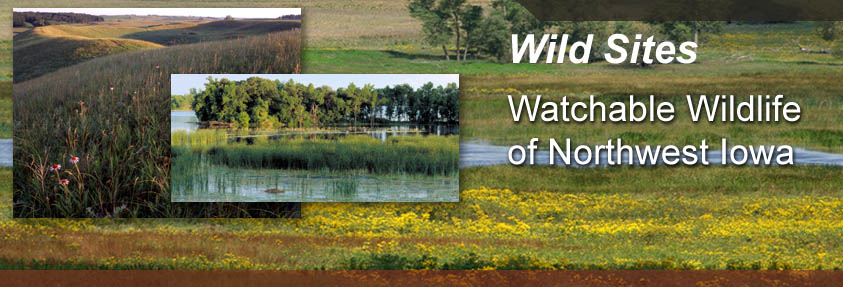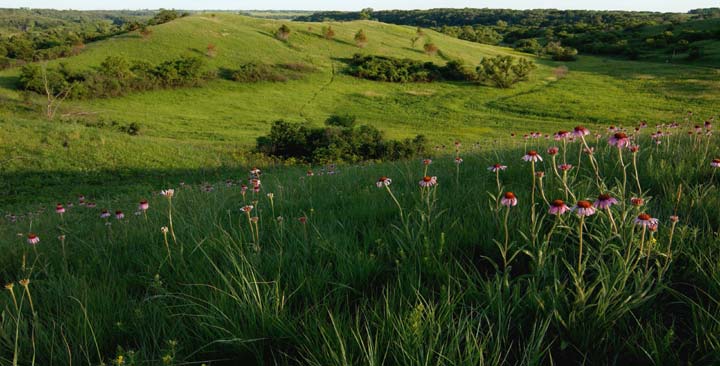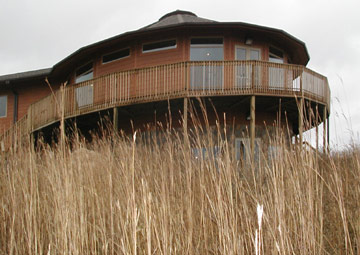 |
|||||||||||||||||||||||||
 |
|||||||||||||||||||||||||
 |
|||||||||||||||||||||||||
| Waterman Prairie
Is this part of Iowa? As the last glacier receded from Iowa, melt water rushed from a dammed lake and cut a steep and scenic valley in its path toward the Missouri River. Waterman Creek and the Little Sioux River flow through the valley providing water and shelter in the trees along their banks. While these features make the land difficult to till, it has been an ideal location for native cultures, early Euro-American settlement and wildlife of all kinds. If you approach from the north side (south of Hwy 9 on Sorrel Avenue and 160th) the trail from the parking lot takes you through the trees out into the prairie. Prairie History Nearly 1,000 years ago, corn farmers were active in the area. The Mill Creek people were a farming and gathering society. A corridor of their village sites can be found along the banks of Waterman Creek and the Little Sioux River. In fact, over 30 recorded sites cluster around the confluence of these streams. The landscape was also appealing to the first Euro-American settlers in the area. Hannibal Waterman, his wife, Hannah, and their daughter, Emily, homesteaded here and helped to establish the homes of other settlers who followed them. A pioneer cemetery perches along the edge of the bluff overlooking the valley on the southern edge of the Waterman Prairie Complex. Location Description The Waterman Prairie Complex is a large tract of public land which extends along the Waterman Creek and Little Sioux watersheds. Riparian habitat and pristine prairies are included in the 1,800 acre complex. Cedar trees in the draws, while a negative for the prairie, provide a protective habitat for wintering birds. Want to see your first robin or bluebird of the year? This is the spot to bird on January 1st! American Robins, Eastern Bluebirds, Cedar Waxwings, Purple Finches and Northern Flickers are winter residents. The area also attracts some of the more unusual related birds such as Bohemian Waxwings, Mountain Bluebirds, and Townsend’s Solitaires. Raptors of all kinds use the valley for hunting and as a migratory route. Bald Eagles use a night roost along the Little Sioux River, drawn to the area throughout the winter due to open water. Golden Eagles have been documented using the valley. Accipiters, Buteos, and Falcons can be seen in abundance. |
|||||||||||||||||||||||||
 |
|||||||||||||||||||||||||
|
Use the Prairie Heritage Center as a start off point to help you explore the large prairie complex filled with special plants and animals. (http://www.prairieheritagecenter.org) Driving Directions and other Information
Educational Activity:
|
|||||||||||||||||||||||||
|
Visit Waterman Prairie via Google Map by Clicking HERE! (Please disable your browser's popup blocker before viewing map) |
|||||||||||||||||||||||||
|
Visit the Video Links below!
|
|||||||||||||||||||||||||
|
|
|||||||||||||||||||||||||
|
Enjoy the prairie at the Prairie Heritage Center with 3rd Graders - have some fun - Click here! |
|||||||||||||||||||||||||
|
|
|||||||||||||||||||||||||
|
Take a short visit to Waterman Prairie in the early spring - Click here! |
|||||||||||||||||||||||||
|
|
|||||||||||||||||||||||||
|
|
|||||||||||||||||||||||||
|
Sit back and watch the Inkpaduta Canoe Race on the Little Sioux River! |
|||||||||||||||||||||||||
|
|
|||||||||||||||||||||||||
| Wild Categories | Photo Gallery | ||||||||||||||||||||||||